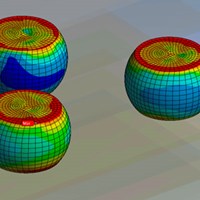Simulate the mechanical behavior of materials in real-world conditions
Ansys Mechanical Pro adds more features to the capabilities of Ansys DesignSpace. It has the same user interface as DesignSpace, resulting in a fast learning experience and greater productivity for regular or occasional users.
Get More with Ansys Mechanical Pro
Contact capabilities
Ansys Mechanical Pro includes a comprehensive range of contact capabilities that enable you to account for the interactions of multiple parts. It can simulate everything from a bonded contact that treats joints between parts as if they are glued or welded together, to contact interfaces that allow parts to move apart and together with or without frictional effects. Being able to simulate contact correctly means that you can simulate the change in load paths when parts deform and confidently predict how assemblies will behave in the real world.
Fatigue analysis
Being able to understand the immediate stresses and deformations a part undergoes is critical to structural analysis. Any part undergoing repeated loading may accumulate damage that will eventually result in part failure even though the loading is not close to the limits of the material. Fatigue analysis enables visualization of life and damage during cyclic loading and can help to predict where failure may occur and increase product durability.
Large deflection
Analysis of geometric nonlinearities caused by large deflections means that much more accuracy can be accounted for due to effects such a stress stiffening. Linear assumptions during structural analysis could lead to inaccuracies.
Ansys Mechanical Pro Capabilities
High-Performance Computing
Ansys Mechanical Pro can use multiple CPU cores when solving. As well as shared memory parallel (SMP) solvers, distributed solvers are available for a large range of analysis types, including linear dynamics. Using additional cores significantly increases solver performance. For larger models, the benefits of additional cores have been seen up to and beyond 1,000 compute cores.
Geometric Nonlinearity
Ansys Mechanical Pro enables nonlinear geometry solutions via a simple solver setting. Program-controlled settings take the guesswork out of solver controls. Geometric nonlinearities occur when a load applied to a structure no longer results in a linear response. This applies for large deflections and large strains. Running an analysis in which large strain or large deflection are present using a linear approach could yield very different results. Enabling large deflection means the solver will run a nonlinear solution, which will account for effects like stress stiffening and large strains. Comparisons between linear and nonlinear solutions are easy to generate using the “solution combination feature” as a comparison tool.
Fatigue module
The post- process fatigue capability in Ansys Mechanical Pro is available to examine stress- and strain-based fatigue without the need to launch a separate tool. Being able to understand the immediate stresses and deformations a part undergoes is critical for structural analysis. Any part undergoing repeated loading may accumulate damage which will eventually result in part failure, even though the loading is not close to the limits of the material. Fatigue analysis lets you visualize damage during cycling of loads, and can help to predict where failure may occur so you can correct the problem and increase product durability.
Contact Capabilities
Ansys Mechanical Pro includes a comprehensive range of contact capabilities so you can account for the interactions of multiple parts. Features range from bonded contact that treats joints between parts as if they are glued or welded together, to contact interfaces that allow parts to move apart and together with or without frictional effects.
You can set up complex shrink or interference fits either from the simulation or from previously created overlapping geometry.
Being able to simulate contact correctly means that engineers can simulate the change in load paths when parts deform and confidently predict how assemblies will behave in the real world.
Multiphysics
Very often the loads on a part or assembly are not just structural. Ansys Mechanical Pro enables easy import of loads from external sources. With Mechanical Pro it’s easy to analyze the interaction of different physics phenomena to better simulate real-world conditions. Example interactions:
- Fluid–Structure interaction (one-way)
- Thermal–Structure interaction (sequential)
- Other interactions through external data
The external data feature lets you import results from any source through a text file. Automatic mapping of data, such as temperature, onto models from dissimilar meshes gives you options to map 2-D data onto 3-D structures (extruded or swept about an axis), providing maximum flexibility.
Simulations from other systems within the Ansys Workbench schematic can easily be linked together for even faster setup times for studying things like applying pressure calculated in CFD to structures.
Thermal Analysis
Ansys Mechanical Pro includes a full range of thermal capabilities for studying both steady-state and transient thermal analysis.
Conduction through parts and across contacts can be set to accurately represent real conditions. Contacts can be adjusted to allow for imperfect conduction across parts where needed. Convection can be set up to represent various scenarios, and a library of predefined conditions is available.
You can perform steady-state and transient thermal analyses of products, including conduction, convection and radiation effects. Modeling phase-change and temperature-dependent materials ensures an accurate simulation.





